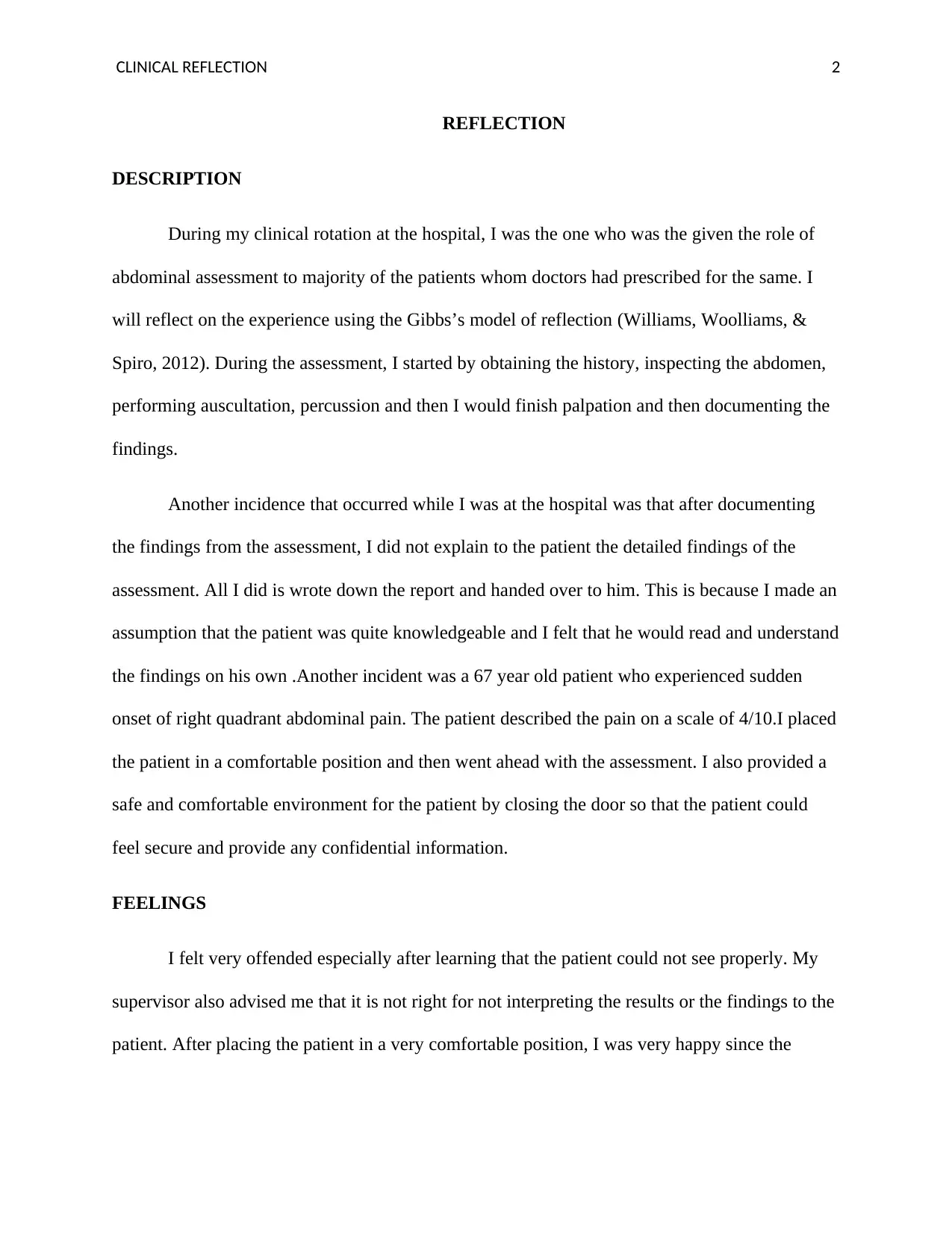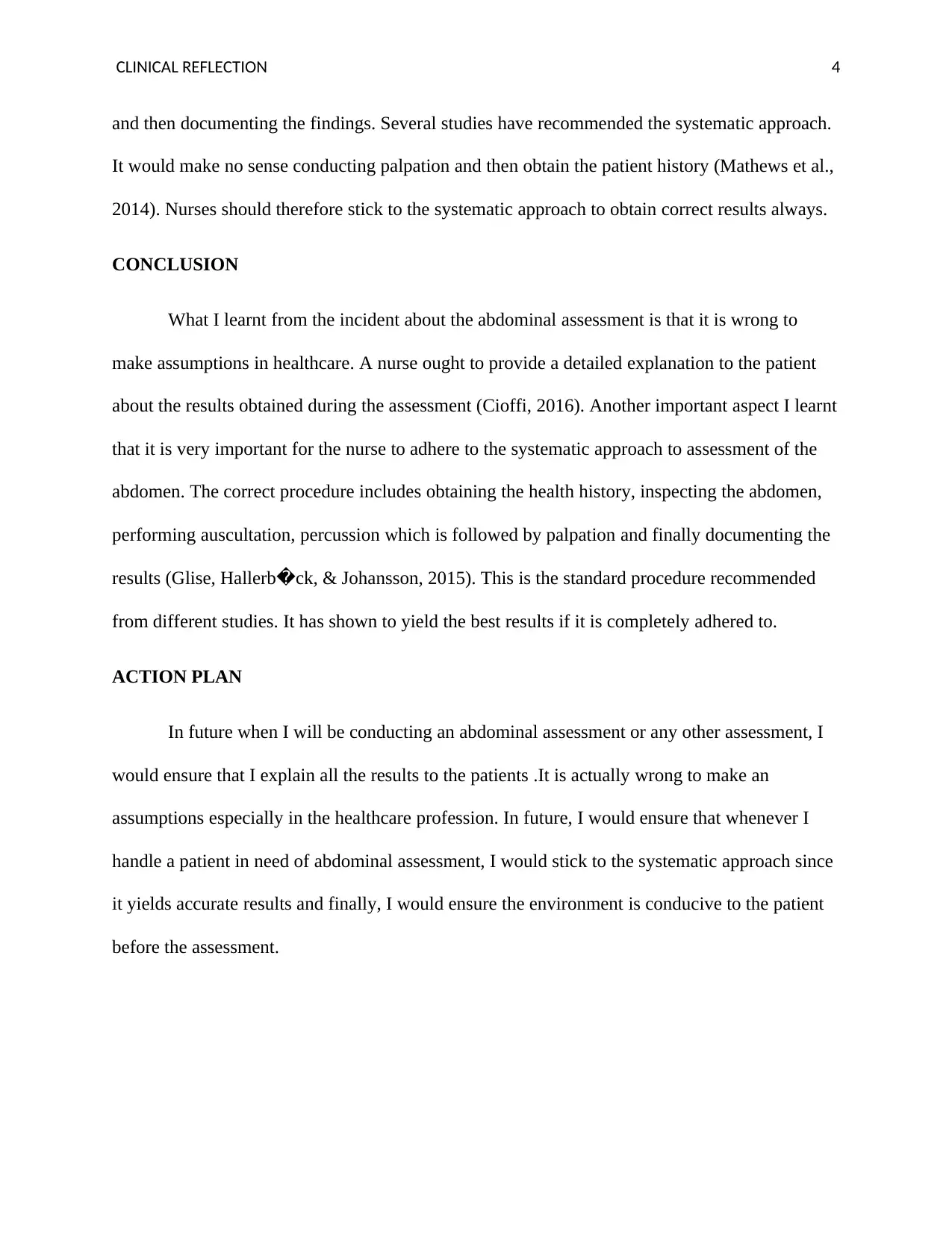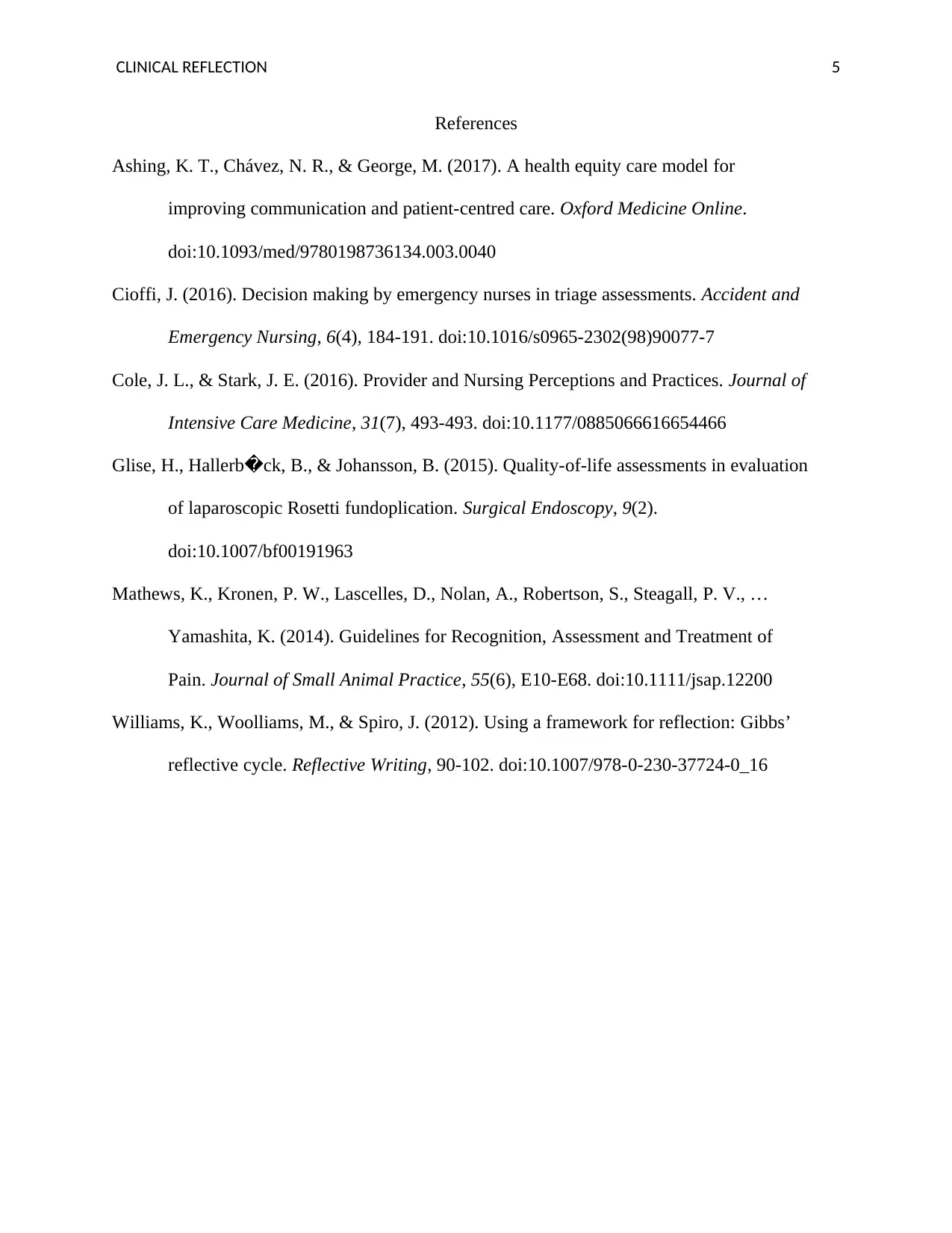Clinical Reflection Report: Abdominal Assessment Using Gibbs Model
VerifiedAdded on 2021/04/21
|5
|1132
|144
Report
AI Summary
This clinical reflection report details a student's experience with abdominal assessments in a hospital setting, utilizing the Gibbs' reflective cycle. The report describes the process of assessment, including obtaining patient history, inspection, auscultation, percussion, and palpation. It highlights an incident where the student failed to explain findings to the patient due to an assumption of the patient's understanding, and another case involving a 67-year-old patient with abdominal pain. The student reflects on their feelings, evaluates the positive and negative aspects of the experience, and analyzes the importance of patient comfort, a systematic approach, and clear communication. The conclusion emphasizes the need to avoid assumptions, adhere to the systematic approach, and ensure a conducive environment for the patient. The action plan outlines steps the student will take in future assessments to improve patient care, including explaining results, following the systematic approach, and ensuring a comfortable environment. References to relevant studies support the reflections and recommendations.

RUNNING HEAD: REFLECTION 1
Reflection
Name:
Institution:
Tutor:
Date:
Reflection
Name:
Institution:
Tutor:
Date:
Paraphrase This Document
Need a fresh take? Get an instant paraphrase of this document with our AI Paraphraser

CLINICAL REFLECTION 2
REFLECTION
DESCRIPTION
During my clinical rotation at the hospital, I was the one who was the given the role of
abdominal assessment to majority of the patients whom doctors had prescribed for the same. I
will reflect on the experience using the Gibbs’s model of reflection (Williams, Woolliams, &
Spiro, 2012). During the assessment, I started by obtaining the history, inspecting the abdomen,
performing auscultation, percussion and then I would finish palpation and then documenting the
findings.
Another incidence that occurred while I was at the hospital was that after documenting
the findings from the assessment, I did not explain to the patient the detailed findings of the
assessment. All I did is wrote down the report and handed over to him. This is because I made an
assumption that the patient was quite knowledgeable and I felt that he would read and understand
the findings on his own .Another incident was a 67 year old patient who experienced sudden
onset of right quadrant abdominal pain. The patient described the pain on a scale of 4/10.I placed
the patient in a comfortable position and then went ahead with the assessment. I also provided a
safe and comfortable environment for the patient by closing the door so that the patient could
feel secure and provide any confidential information.
FEELINGS
I felt very offended especially after learning that the patient could not see properly. My
supervisor also advised me that it is not right for not interpreting the results or the findings to the
patient. After placing the patient in a very comfortable position, I was very happy since the
REFLECTION
DESCRIPTION
During my clinical rotation at the hospital, I was the one who was the given the role of
abdominal assessment to majority of the patients whom doctors had prescribed for the same. I
will reflect on the experience using the Gibbs’s model of reflection (Williams, Woolliams, &
Spiro, 2012). During the assessment, I started by obtaining the history, inspecting the abdomen,
performing auscultation, percussion and then I would finish palpation and then documenting the
findings.
Another incidence that occurred while I was at the hospital was that after documenting
the findings from the assessment, I did not explain to the patient the detailed findings of the
assessment. All I did is wrote down the report and handed over to him. This is because I made an
assumption that the patient was quite knowledgeable and I felt that he would read and understand
the findings on his own .Another incident was a 67 year old patient who experienced sudden
onset of right quadrant abdominal pain. The patient described the pain on a scale of 4/10.I placed
the patient in a comfortable position and then went ahead with the assessment. I also provided a
safe and comfortable environment for the patient by closing the door so that the patient could
feel secure and provide any confidential information.
FEELINGS
I felt very offended especially after learning that the patient could not see properly. My
supervisor also advised me that it is not right for not interpreting the results or the findings to the
patient. After placing the patient in a very comfortable position, I was very happy since the

CLINICAL REFLECTION 3
patient was very comfortable and he was answering the questions as asked. I was happy since the
comfortable environment was also conducive for me and the patient.
EVALUATION
There overall experience was of mixed fortunes. Some of the experiences were quite
positive while others were negative. Another important aspect of the incident was that I was able
to place the 67 year old patient in a comfortable position and provided a safe environment as
recommended by the different studies. The experience that was positive was the one concerning
the systematic approach to the assessment since it enabled me to get the correct results.
ANALYSIS
After the incidence, I gained important points and knowledge .I learnt that the position
and the environment the patient is can have a big impact on the outcome of the assessment.
According to studies, the position in which a patient is placed as well as the environment has an
impact on the results that can be obtained during assessment (Ashing, Chávez, & George, 2017).
The assessment involves obtaining medical history of both the patient and the family. The nurse
should therefore provide a comfortable environment so that the patient feels secure to provide
such confidential information (Cole & Stark, 2016). In this case ,I therefore made the position sit
in a comfortable position so as to provide the correct scale of pain and the door was closed so
that no one could hear the conversation .Nurses are also advised to put into consideration such
factors during assessment.
I also learnt that to obtain accurate results during assessment, it is necessary for the nurse
to adhere to the systematic approach. This includes obtaining the health history of the patient,
inspecting the abdomen, performing auscultation, percussion and then I would finish palpation
patient was very comfortable and he was answering the questions as asked. I was happy since the
comfortable environment was also conducive for me and the patient.
EVALUATION
There overall experience was of mixed fortunes. Some of the experiences were quite
positive while others were negative. Another important aspect of the incident was that I was able
to place the 67 year old patient in a comfortable position and provided a safe environment as
recommended by the different studies. The experience that was positive was the one concerning
the systematic approach to the assessment since it enabled me to get the correct results.
ANALYSIS
After the incidence, I gained important points and knowledge .I learnt that the position
and the environment the patient is can have a big impact on the outcome of the assessment.
According to studies, the position in which a patient is placed as well as the environment has an
impact on the results that can be obtained during assessment (Ashing, Chávez, & George, 2017).
The assessment involves obtaining medical history of both the patient and the family. The nurse
should therefore provide a comfortable environment so that the patient feels secure to provide
such confidential information (Cole & Stark, 2016). In this case ,I therefore made the position sit
in a comfortable position so as to provide the correct scale of pain and the door was closed so
that no one could hear the conversation .Nurses are also advised to put into consideration such
factors during assessment.
I also learnt that to obtain accurate results during assessment, it is necessary for the nurse
to adhere to the systematic approach. This includes obtaining the health history of the patient,
inspecting the abdomen, performing auscultation, percussion and then I would finish palpation
⊘ This is a preview!⊘
Do you want full access?
Subscribe today to unlock all pages.

Trusted by 1+ million students worldwide

CLINICAL REFLECTION 4
and then documenting the findings. Several studies have recommended the systematic approach.
It would make no sense conducting palpation and then obtain the patient history (Mathews et al.,
2014). Nurses should therefore stick to the systematic approach to obtain correct results always.
CONCLUSION
What I learnt from the incident about the abdominal assessment is that it is wrong to
make assumptions in healthcare. A nurse ought to provide a detailed explanation to the patient
about the results obtained during the assessment (Cioffi, 2016). Another important aspect I learnt
that it is very important for the nurse to adhere to the systematic approach to assessment of the
abdomen. The correct procedure includes obtaining the health history, inspecting the abdomen,
performing auscultation, percussion which is followed by palpation and finally documenting the
results (Glise, Hallerb�ck, & Johansson, 2015). This is the standard procedure recommended
from different studies. It has shown to yield the best results if it is completely adhered to.
ACTION PLAN
In future when I will be conducting an abdominal assessment or any other assessment, I
would ensure that I explain all the results to the patients .It is actually wrong to make an
assumptions especially in the healthcare profession. In future, I would ensure that whenever I
handle a patient in need of abdominal assessment, I would stick to the systematic approach since
it yields accurate results and finally, I would ensure the environment is conducive to the patient
before the assessment.
and then documenting the findings. Several studies have recommended the systematic approach.
It would make no sense conducting palpation and then obtain the patient history (Mathews et al.,
2014). Nurses should therefore stick to the systematic approach to obtain correct results always.
CONCLUSION
What I learnt from the incident about the abdominal assessment is that it is wrong to
make assumptions in healthcare. A nurse ought to provide a detailed explanation to the patient
about the results obtained during the assessment (Cioffi, 2016). Another important aspect I learnt
that it is very important for the nurse to adhere to the systematic approach to assessment of the
abdomen. The correct procedure includes obtaining the health history, inspecting the abdomen,
performing auscultation, percussion which is followed by palpation and finally documenting the
results (Glise, Hallerb�ck, & Johansson, 2015). This is the standard procedure recommended
from different studies. It has shown to yield the best results if it is completely adhered to.
ACTION PLAN
In future when I will be conducting an abdominal assessment or any other assessment, I
would ensure that I explain all the results to the patients .It is actually wrong to make an
assumptions especially in the healthcare profession. In future, I would ensure that whenever I
handle a patient in need of abdominal assessment, I would stick to the systematic approach since
it yields accurate results and finally, I would ensure the environment is conducive to the patient
before the assessment.
Paraphrase This Document
Need a fresh take? Get an instant paraphrase of this document with our AI Paraphraser

CLINICAL REFLECTION 5
References
Ashing, K. T., Chávez, N. R., & George, M. (2017). A health equity care model for
improving communication and patient-centred care. Oxford Medicine Online.
doi:10.1093/med/9780198736134.003.0040
Cioffi, J. (2016). Decision making by emergency nurses in triage assessments. Accident and
Emergency Nursing, 6(4), 184-191. doi:10.1016/s0965-2302(98)90077-7
Cole, J. L., & Stark, J. E. (2016). Provider and Nursing Perceptions and Practices. Journal of
Intensive Care Medicine, 31(7), 493-493. doi:10.1177/0885066616654466
Glise, H., Hallerb�ck, B., & Johansson, B. (2015). Quality-of-life assessments in evaluation
of laparoscopic Rosetti fundoplication. Surgical Endoscopy, 9(2).
doi:10.1007/bf00191963
Mathews, K., Kronen, P. W., Lascelles, D., Nolan, A., Robertson, S., Steagall, P. V., …
Yamashita, K. (2014). Guidelines for Recognition, Assessment and Treatment of
Pain. Journal of Small Animal Practice, 55(6), E10-E68. doi:10.1111/jsap.12200
Williams, K., Woolliams, M., & Spiro, J. (2012). Using a framework for reflection: Gibbs’
reflective cycle. Reflective Writing, 90-102. doi:10.1007/978-0-230-37724-0_16
References
Ashing, K. T., Chávez, N. R., & George, M. (2017). A health equity care model for
improving communication and patient-centred care. Oxford Medicine Online.
doi:10.1093/med/9780198736134.003.0040
Cioffi, J. (2016). Decision making by emergency nurses in triage assessments. Accident and
Emergency Nursing, 6(4), 184-191. doi:10.1016/s0965-2302(98)90077-7
Cole, J. L., & Stark, J. E. (2016). Provider and Nursing Perceptions and Practices. Journal of
Intensive Care Medicine, 31(7), 493-493. doi:10.1177/0885066616654466
Glise, H., Hallerb�ck, B., & Johansson, B. (2015). Quality-of-life assessments in evaluation
of laparoscopic Rosetti fundoplication. Surgical Endoscopy, 9(2).
doi:10.1007/bf00191963
Mathews, K., Kronen, P. W., Lascelles, D., Nolan, A., Robertson, S., Steagall, P. V., …
Yamashita, K. (2014). Guidelines for Recognition, Assessment and Treatment of
Pain. Journal of Small Animal Practice, 55(6), E10-E68. doi:10.1111/jsap.12200
Williams, K., Woolliams, M., & Spiro, J. (2012). Using a framework for reflection: Gibbs’
reflective cycle. Reflective Writing, 90-102. doi:10.1007/978-0-230-37724-0_16
1 out of 5
Related Documents
Your All-in-One AI-Powered Toolkit for Academic Success.
+13062052269
info@desklib.com
Available 24*7 on WhatsApp / Email
![[object Object]](/_next/static/media/star-bottom.7253800d.svg)
Unlock your academic potential
Copyright © 2020–2025 A2Z Services. All Rights Reserved. Developed and managed by ZUCOL.





